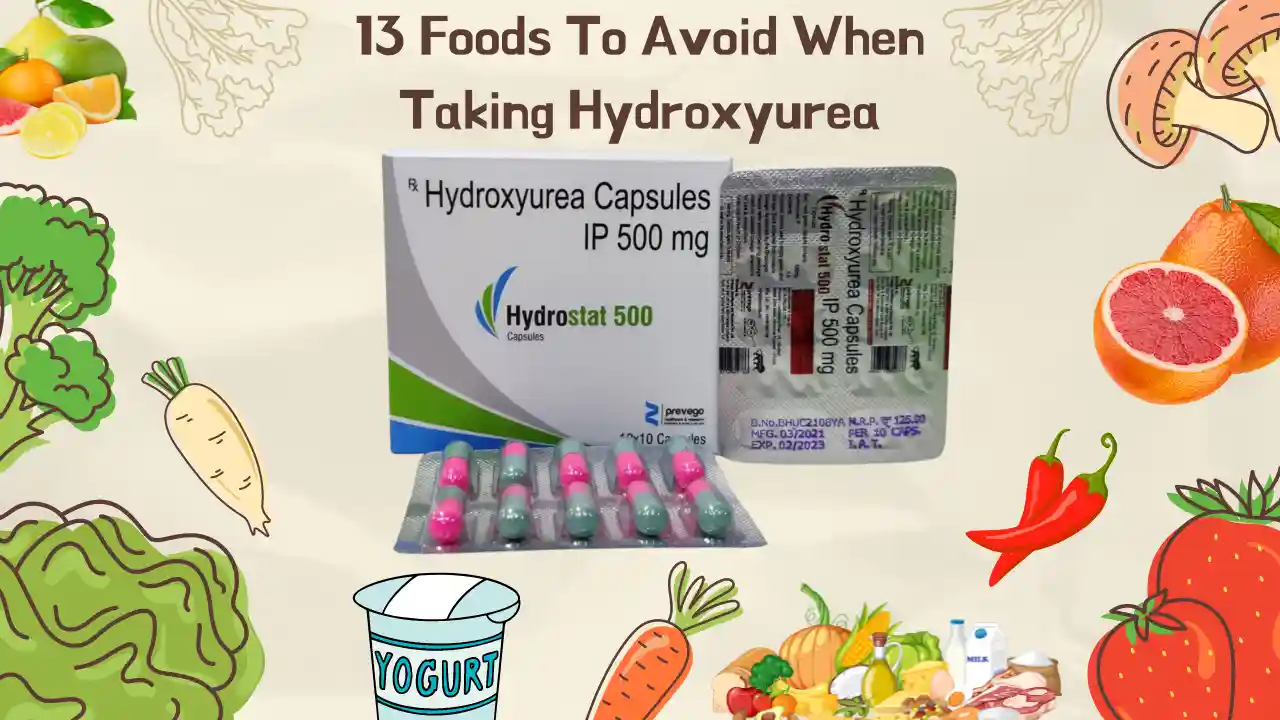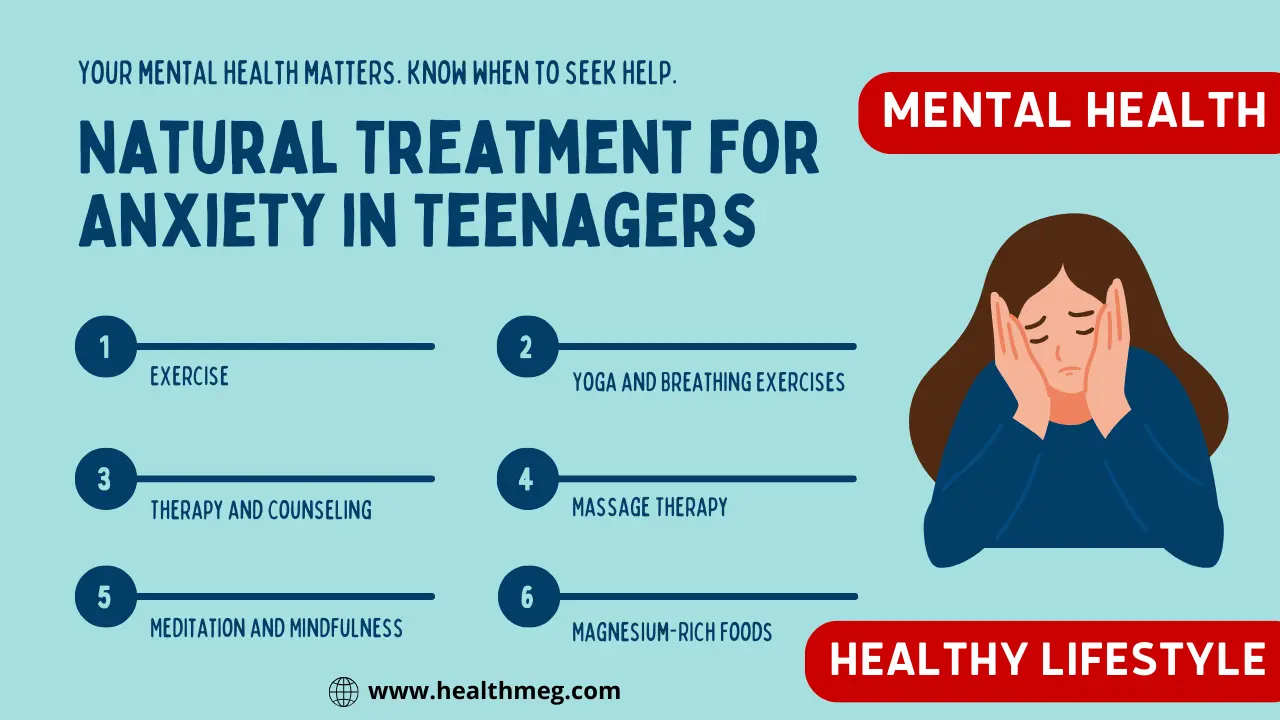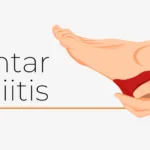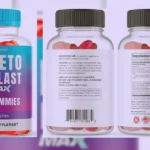Are you using hydroxyurea for a health issue like cancer or sickle cell anaemia? Your diet can greatly influence how well this medicine works and the side effects you might have. It’s important to know which foods to stay away from and which ones are okay to eat to get the most out of your hydroxyurea treatment.
Hydroxyurea is a usual chemotherapy drug (a medicine used to treat cancer) used for some types of cancer and blood problems. It works by stopping the creation of DNA parts that cancer cells need to grow and split. While hydroxyurea is helpful, it can have possible side effects.
One way to lessen side effects is to watch what you eat when taking this medicine. Some foods can interact with hydroxyurea or make its side effects worse. But, other foods are totally safe and can be added to your diet.
Let’s see 13 Foods To Avoid When Taking Hydroxyurea, why it’s better to skip these foods, and what foods you can still enjoy eating while taking hydroxyurea.
What is Hydroxyurea and How Does It Work?
Hydroxyurea is a cancer medicine that you swallow as a capsule or tablet. Doctors often give it for:
- Chronic myeloid leukaemia (CML) – a kind of blood cancer
- Polycythemia vera – a blood problem where you have too many red blood cells
- Essential thrombocytosis – a blood disease where you have too many platelets
- Sickle cell anaemia – a genetic problem with the red blood cells
- Some cancers of the head and neck
Hydroxyurea works by stopping an enzyme called ribonucleotide reductase. This enzyme changes ribonucleotides into deoxyribonucleotides. These are the parts that cancer cells need to split and copy their DNA.
Hydroxyurea can help slow down or stop the growth of cancer cells by stopping this enzyme. It also makes more fetal haemoglobin in people with sickle cell disease. This stops the red blood cells from becoming sickle-shaped.
But, because hydroxyurea affects all cells that grow quickly, it can also affect healthy cells in the body. This can cause side effects. The kidneys remove hydroxyurea from the body within a few hours. However, side effects may appear over time.
There are many issues related to cancer. One of them includes that you must know is – Is Heel Pain a Sign of Cancer?
Should Hydroxyurea Be Taken With Food?
You can take hydroxyurea with or without food. The medicine is best absorbed on an empty stomach. But, taking it after a meal or at bedtime may help reduce loss of appetite. This is a common side effect.
Some sources suggest taking hydroxyurea with a small meal or snack. This can lessen potential stomach upset, nausea or diarrhoea. Work with your doctor to figure out the best timing. Taking it the same way each day gives the best results.
Now that we’ve covered the basics of hydroxyurea therapy, let’s talk about which foods you should avoid while taking this medicine.
13 Foods To Avoid When Taking Hydroxyurea
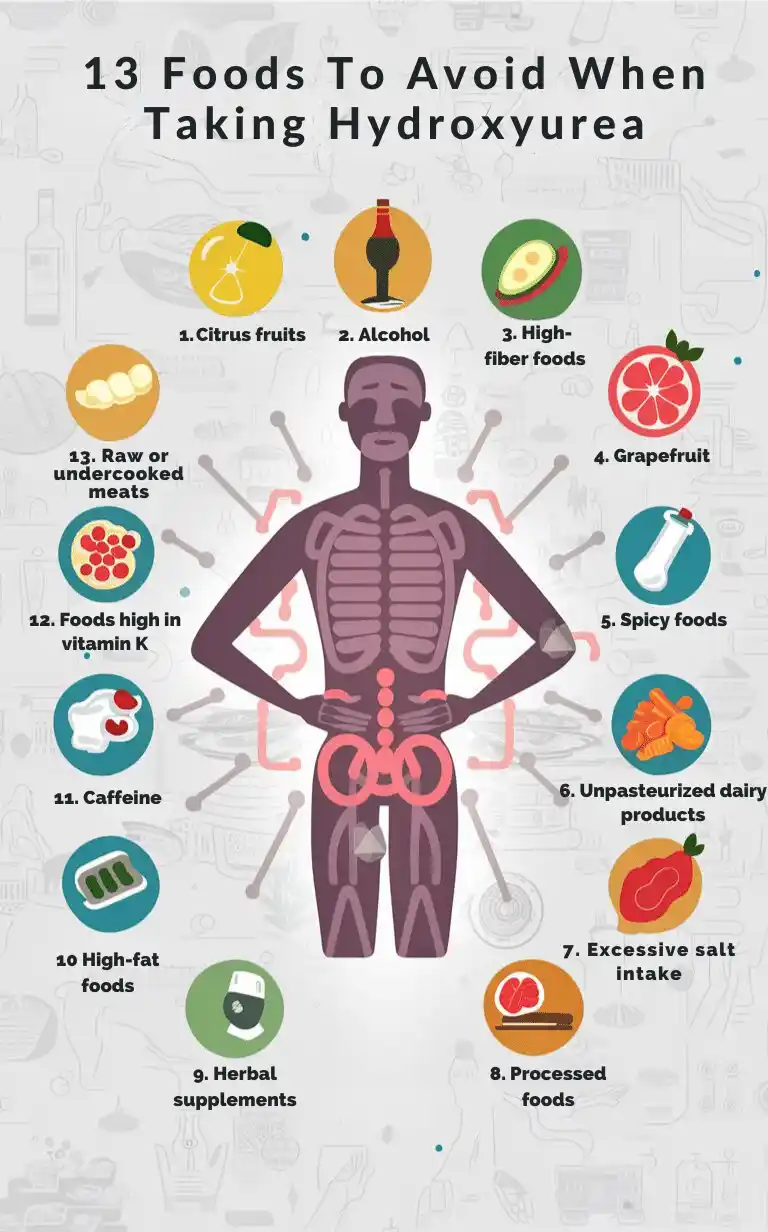
Certain foods and beverages can interact with hydroxyurea or exacerbate side effects. Here are 13 foods to avoid:
1. Citrus fruits
Citrus fruits like oranges, lemons, limes, and grapefruit contain compounds called furanocoumarins and flavonoids that interfere with cytochrome P450 enzymes and transport proteins in the body. These mechanisms are critical for metabolizing and eliminating hydroxyurea. Eating these fruits can cause too much hydroxyurea to build up in your body, which can be harmful.
2. Alcohol
Alcohol is broken down by the same liver enzymes and transport proteins that metabolize and excrete hydroxyurea – CYP3A4 and p-glycoprotein. When alcohol is present, it competes with and blocks hydroxyurea from being properly metabolized. This leads to elevated hydroxyurea levels and more severe side effects. Alcohol also suppresses the immune system, which is already lowered by hydroxyurea therapy. Having even a few drinks can increase the risk of infections and poor wound healing.
3. High-fiber foods
A high-fiber diet has been shown to accelerate “gut motility” – the rate at which contents move through the GI tract. This faster transit time means oral drugs like hydroxyurea have less time to be absorbed in the small intestine. More hydroxyurea is excreted in the stool before it can enter the bloodstream. Temporarily limiting high-fibre foods to <25g daily can allow for improved absorption and therapeutic levels.
4. Grapefruit
While it’s well-documented that grapefruit and grapefruit juice can interact with various drugs due to compounds called furanocoumarins. Furanocoumarins in grapefruit can inhibit certain enzymes in the body, potentially altering the metabolism and absorption of various medications. This could theoretically lead to higher drug concentrations in the blood and increased risk of side effects.
5. Spicy foods
Chemotherapy drugs like hydroxyurea can damage quickly dividing cells along the GI tract, leading to painful mouth and throat sores, or mucositis. Capsaicin and other compounds in spicy foods can further irritate and inflame these sensitive areas. Avoiding hot sauces and spices like chilli peppers can help minimize discomfort if mouth sores develop.
6. Unpasteurized dairy products
Drinking raw milk or eating cheeses made from unpasteurized milk can expose you to bacteria like Listeria, Salmonella, E. coli, and Brucella. Your immune system is weakened while taking hydroxyurea, making foodborne illnesses much more dangerous. Only consume pasteurized milk, cheese, yoghurt and other dairy products to avoid potentially life-threatening infections.
There are many cases in which dairy products can affect your health. One of them includes – Why No Dairy Products After Dental Implant Surgery?
7. Excessive salt intake
Consuming high amounts of sodium from table salt, canned soups, fast food, cured meats and salty snacks can worsen side effects of hydroxyurea like fluid retention, swelling, high blood pressure, and heart failure symptoms. Limit total sodium to 1500-2000 mg daily by focusing on fresh, whole foods and avoiding processed items high in salt.
8. Processed foods
Heavily processed foods tend to be higher in sodium, saturated fat, preservatives, and chemical additives. This can increase inflammation and worsen certain chemotherapy side effects. Choosing mostly whole, unprocessed foods like fruits, vegetables, whole grains, lean proteins, legumes, eggs, nuts and seeds can help you feel better during treatment.
9. Herbal supplements
Herbal supplements like St. John’s Wort, echinacea, ginger, ginseng, garlic and ginkgo can affect enzymes and transporters needed to metabolize and excrete hydroxyurea. This leads to unpredictable changes in hydroxyurea blood levels, impacting the effectiveness and toxicity. Always check with your oncologist before taking herbal supplements with hydroxyurea.
10. High-fat foods
Diets high in saturated fat and cholesterol have been associated with increased inflammation markers. Inflammation can worsen common chemotherapy side effects like fatigue, nausea, diarrhoea, and mouth sores. Focus on getting healthy fats from foods like salmon, avocados, olive oil, nuts and seeds instead of high-fat red meat and fried foods.
11. Caffeine
Consuming more than 2-3 caffeinated beverages per day can compound the side effects of hydroxyurea like headaches, insomnia, anxiety, dehydration, and loss of appetite. Caffeine also causes the body to excrete medications more rapidly which could impact hydroxyurea levels. Limit coffee, tea, soda, and energy drinks to avoid worsening symptoms.
12. Foods high in vitamin K
Hydroxyurea can lower your ability to form blood clots. Vitamin K is needed for blood clotting. Eating large amounts of vitamin K foods could potentially counteract hydroxyurea’s anticlotting effects. While not proven, caution is advised with high-vitamin K foods like kale, spinach, broccoli, cabbage, fish oils, soybean oil, and canola oil.
13. Raw or undercooked meats
Eating raw or undercooked beef, poultry, pork, fish and eggs substantially increases the risk of food poisoning by bacteria and parasites. Hydroxyurea lowers your white blood cells that normally fight infections, so foodborne illnesses can become life-threatening. Use a food thermometer and cook meats to safe internal temperatures.
Why Should You Avoid These Foods with Hydroxyurea?
Now that you know which foods to avoid, let’s explore why they’re problematic when taking hydroxyurea.
As mentioned, high-fiber foods can reduce absorption of hydroxyurea, causing blood levels to drop. Grapefruit, herbs, caffeine and alcohol interact with liver enzymes, leading to unstable hydroxyurea levels.
Raw foods heighten infection risk due to hydroxyurea’s immune-suppressing effects. And tyramine, vitamin K and liquorice may directly increase the drug’s toxicity or side effects.
Consuming these foods alongside hydroxyurea treatment raises your risk of side effects like:
- Low blood cell counts
- Nausea, vomiting, diarrhoea
- Loss of appetite
- Fatigue
- Hair loss
- Headache
- Fever or chills from infection
- Dangerously high blood pressure
By avoiding foods that interact with hydroxyurea, you can minimize these risks and support your body’s ability to safely metabolize this chemotherapy drug.
You can check the top 7 Effective DHT Blocker Exercises To Control your Hair Loss here.
What Foods Are Safe to Eat with Hydroxyurea?
While some foods should be limited or avoided, many healthy and nutritious options can be enjoyed in moderation while taking hydroxyurea:
- Cooked fruits and vegetables provide antioxidants and phytonutrients. Stick to gentle-cooked options to reduce fibre.
- Lean proteins: Choose low-fat options like skinless chicken, fish, eggs, or plant-based proteins. Avoid raw meats.
- Dairy products – Opt for low-fat yoghurt, milk or cheese. Consume pasteurized products only.
- Whole grains – Pick lower-fiber grains like white rice, bread or pasta. Avoid bran or high-fiber cereals.
- Legumes: Well-cooked lentils, beans, or peas provide protein but limit portion sizes to reduce fibre.
- Healthy fats: Include options like olive oil, avocado, nuts, and seeds. Avoid greasy, fried foods.
- Stay hydrated: Drink 8–10 glasses of fluids daily to prevent dehydration, unless fluids are restricted. Avoid alcohol and caffeinated beverages.
Practical Tips for Managing Your Diet with Hydroxyurea
Making appropriate dietary changes while taking hydroxyurea doesn’t have to be complicated. Here are some tips:
- Discuss your diet with your healthcare provider. Create an eating plan tailored for you.
- Closely monitor for side effects that emerge after eating certain foods. Identify and avoid your triggers.
- Cook fruits and vegetables to reduce their fibre content. This helps maintain nutritional intake.
- Choose fresh or frozen options over processed, canned and pre-packaged items.
- Drink fluids between meals rather than with meals to prevent impeding hydroxyurea absorption.
- Season foods with lemon juice instead of eating whole lemons or limes.
- Satisfy citrus cravings with small amounts of peeled, segmented fruit as tolerated.
- Take care when eating out. Ask about food preparation techniques and ingredients.
- Consider keeping a food journal to identify problematic items.
- Deal with appetite changes by eating smaller, more frequent meals.
- Manage nausea by avoiding food smells and eating bland, cold foods.
- Opt for low-fat dairy to reduce gastrointestinal upset.
Conclusion
When taking hydroxyurea, being mindful of your diet can really make a difference in the side effects and overall tolerability of this chemotherapy medication. While citrus fruits, alcohol, raw dairy and undercooked meats should be avoided, you can work with your healthcare provider to tailor your diet with safe, nutritious foods. With some adjustments, you can still enjoy eating while undergoing hydroxyurea therapy.
People Also Ask (FAQs)
Q) How can I reduce the side effects of hydroxyurea?
A) Tips to reduce hydroxyurea side effects include staying hydrated, getting bloodwork regularly, taking folic acid supplements, avoiding alcohol, and reporting all side effects to your doctor so adjustments can be made. Gradual dosage titrations can also help manage side effects.
Q) What happens when you stop hydroxyurea?
A) When hydroxyurea is stopped abruptly, there is a risk of rebound effects where red blood cell production rapidly increases again. This is dangerous. Hydroxyurea must always been tapered gradually under medical supervision to transition safely.
Q) When should I stop taking hydroxyurea?
A) Hydroxyurea should only be stopped under the direction of your prescribing doctor, who will decide when the benefits no longer outweigh the risks or side effects. They will have you taper slowly rather than quitting hydroxyurea suddenly.
Q) What is a natural alternative to hydroxyurea?
A) There are no proven natural alternatives to replace hydroxyurea at this time. Lifestyle measures like hydration, folate supplements, and avoiding infections can complement treatment but do not mimic the effects of hydroxyurea and should not be used to replace this medication without medical advice.
Q) Is hydroxyurea good or bad?
A) Hydroxyurea is very effective at lowering abnormally high white blood cell and platelet counts, reducing risk of blood clots and bleeding. But it has some challenging side effects. Under medical guidance to maximize benefits and minimize risks, hydroxyurea can be a very helpful treatment option for certain blood disorders.
